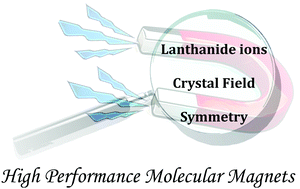Enriching lanthanide single-ion magnetism through symmetry and axiality
Abstract
Rapidly growing modern information technology demands energy and cost efficient tools that can efficiently store and process a large amount of data. However, the miniaturization technology that was being used to boost the performance of the electronic devices, keeping up with the pace as estimated by Moore's law, is reaching its limit. To overcome these challenges, several alternative routes that can eventually mimic the modern electronics fabrication using silicon have been proposed. Single molecule magnets (SMMs), being considered as one of the potential alternatives, have gone through significant progress and the focus has shifted from the use of polynuclear clusters to mononuclear complexes in the last few years. The recent frenzy in the field of SMMs is driven by a better understanding of the effects of crystal field (CF) and molecular symmetry on the magnetic properties, especially in the case of mononuclear paramagnetic complexes, apart from other controlling factors. This has led to the advent of highly anisotropic single-ion magnets (SIMs) with magnetic blocking temperatures as high as 60 K and anisotropic energy barriers over 1800 K. This article overviews our recent research in the light of the emergence of the importance of CF and symmetry in 4f ion based single-ion magnets (SIMs), especially in the context of SIMs with D5h symmetry, apart from commenting on the synthetic efforts adopted to place these metal ions in unusual coordination geometries.



 Please wait while we load your content...
Please wait while we load your content...